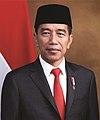East Asia Summit
The East Asia Summit (EAS) is a regional forum held annually by leaders of, initially, 16 countries in the East Asian, Southeast Asian, South Asian and Oceanian regions, based on the ASEAN Plus Six mechanism. Membership expanded to 18 countries including Russia and the United States at the Sixth EAS in 2011. Since its establishment, ASEAN has held the central role and leadership in the forum. EAS meetings are held after the annual ASEAN leaders' meetings, and plays an important role in the regional architecture of Asia-Pacific. The first summit was held in Kuala Lumpur, Malaysia on 14 December 2005.[1][2]
History[edit]
History prior to the first East Asia Summit[edit]
The concept of an East Asia Grouping has significant history going back to an idea first promoted in 1991 by then Malaysian Prime Minister Mahathir Mohamad.
The final report in 2002 of the East Asian Study Group, established by the ASEAN Plus Three countries, was based on an EAS involving ASEAN Plus Three, therefore not involving Australia, New Zealand, or India.[3] The EAS as proposed was to be an ASEAN-led development, with the summit to be linked to ASEAN summit meetings. However, the issue was to which countries beyond those in ASEAN the EAS was to be extended.
The decision to hold the EAS was reached during the 2004 ASEAN Plus Three summit and the initial 16 members determined at the ASEAN Plus Three Ministerial Meeting held in Laos at the end of July 2005.[4]
Credit for advancing the forum during the 2004 ASEAN Plus Three summit has been attributed to Malaysia.[5]
Energy[edit]
At the Second EAS the EAS members signed the Cebu Declaration on East Asian Energy Security, a declaration on energy security and biofuels, containing a statement for members to prepare non-binding targets.[23]
Relationship with ASEAN Plus Three[edit]
The relationship between the EAS on one hand and ASEAN Plus Three on the other is still not clear. As discussed above, some countries are more supportive of the narrower ASEAN Plus Three grouping whereas others support the broader, more inclusive EAS. ASEAN Plus Three, which has been meeting since December 1997[39] has a history, including the Chiang Mai Initiative[40] which appears to have led to the development of the Asian Monetary Unit. This may be significant for those advocating a broader role for EAS in the future.
The tension between the groupings extends to the respective members' intentions towards future Free Trade Agreements with China and South Korea focused on ASEAN Plus Three and Japan on the broader EAS members.[41]
The 1997 Asian financial crisis had demonstrated the need for regional groupings and initiatives. It was during this time ASEAN Plus Three had commenced and it was also during this time that the East Asian caucus was being discussed.
The EAS is just one regional grouping and some members down play its significance, the former Australian Prime Minister John Howard has stated that the EAS was secondary as a regional summit to APEC which has on his view a premier role.[42] Not all members of the EAS, notably India, are members of APEC. However, as the EAS meetings are scheduled with the ASEAN Plus Three meetings (they both follow the annual ASEAN meetings) and all members of ASEAN Plus Three are members of EAS the ability of the two forums to remain relevant given the existence of the other remains in question. China has stated its preference for both EAS and ASEAN Plus Three to exist side by side.[43]
The relationship between APEC, ASEAN Plus Three and the EAS remained unresolved heading into the 2007 APEC meeting.[44] Following the meeting the then Malaysian Prime Minister Abdullah Ahmad Badawi described ASEAN Plus Three as the primary vehicle and implied APEC was the lesser of the three.[45] At the same time a Malaysian commentator writing in a Singaporean newspaper described concentric circles for the three with ASEAN Plus Three at the centre and APEC at the outer, also suggested the Nikai Initiative, with its regional OECD like plans, might overtaking the remaining role for APEC.[46]
Countries joining the Summit process[edit]
Russia[edit]
Russia participated in the first EAS as an observer at the invitation of 2005 host Malaysia and requested to become a member. Its request to become a future member received support from China and India.[47]
The membership of EAS was to be considered by ASEAN on a case-by-case basis.[48] ASEAN decided to freeze new "membership" of EAS for the second and third summits.[49]
The status of potential future members was discussed in the Chairman's Statement of the 16th ASEAN Summit (9 April 2010)[50] in these terms:
Potential future members[edit]
East Timor and Papua New Guinea[edit]
East Timor is a candidate ASEAN member seeking membership within five years (from 2006) and Papua New Guinea has shown intention to join;[55][56][57] presumably new members of ASEAN would also join the EAS.[58]
Other countries and groupings[edit]
Over several years, especially shortly the commencement of the summits, other countries have been connected with the EAS.
In 2006, Pakistan and Mongolia were proposed as future members by Malaysia.[59] Mongolia was mentioned again by Vietnam, the then chair, in 2010.[60]
In 2007, Pakistan and Bangladesh were raised by Japan as possible members.[61]
In 2007, the European Union indicated it wishes to have a role as an observer.[62]
In 2008, the Arab League held talks and expressed its desire to have a role as an observer.[63]
In 2017, Sri Lanka and Maldives were proposed to be possible members of East Asia Summit. Prime Minister of Canada Justin Trudeau attended as guest. He had arrived directly from the APEC 2017 summit held in Da Nang, Vietnam.

















